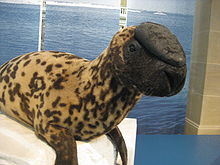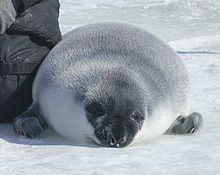- Hooded seal
-
Hooded seal[1] 
Conservation status Scientific classification Kingdom: Animalia Phylum: Chordata Class: Mammalia Order: Carnivora Family: Phocidae Genus: Cystophora
Nilsson, 1820Species: C. cristata Binomial name Cystophora cristata
(Erxleben, 1777)
Distribution of the hooded seal. Breeding grounds indicated in blue. The hooded seal (Cystophora cristata) is an arctic pinniped found only in the central and western North Atlantic ranging from Svalbard in the east to the Gulf of St. Lawrence in the west.
Contents
Naming
The generic name means "bladder-bearer" in Greek, from the peculiar inflatable bladder on the head of the adult male – this bladder hangs between his eyes and down over his upper lip in the deflated state. In addition, he can inflate a large balloon-like sac from one of his nostrils. This is done by shutting one nostril valve and inflating a membrane which then protrudes from the other nostril.[3]
The bulge
The bulge develops when the seal is four years old. The male can blow up this bulge, so that it is the size of its head.
Size
Adult males are 2.6 metres (8 ft 6 in) long on average, and weigh 300–410 kg (660–900 lb). Sexual dimorphism is obvious from birth and females are much smaller: 2.03 metres (6 ft 8 in) long and weighing 145–300 kg (320–660 lb).[4][5] The colour is silvery; the body is scattered with dark, irregular marks. The head is darker than the rest of the body, and without marks.
Life cycle
In April through June, after the breeding season, this species travels long distances to feed and eventually gather together again in separate moulting areas on the ice from June through August. After moulting, it disperses widely again to feed in the late summer and autumn before returning to the breeding areas in late winter.
Breeding
There are four major breeding areas: the Gulf of St. Lawrence, the "Front" east of Newfoundland, Davis Strait (between Greenland and northern Canada) and the West Ice near Jan Mayen.
Offspring
Pups are about 1 metre (3 ft 3 in) long at birth and weigh about 24 kilograms (53 lb). They are born on the ice from mid-March to early April with a well-developed blubber layer and having shed their pre-natal coat. They are born with a slate blue-grey coat (giving them the name "blueback"), with a pale cream color on the belly, which they will moult after about 14 months. Nursing of the pup lasts for an average of only 4 days, the shortest lactation period of any mammal, during which the pup doubles in size, gaining around 7 kg/day. This is possible because the milk that they drink has a fat content of 60%.[6] The female pup will mature between ages 3 and 6, whereas the male pup will mature between ages 5 and 7.
Lifespan
The hooded seal can live to about age 30 to 35.
References
- ^ Wozencraft, W. Christopher (16 November 2005). "Order Carnivora (pp. 532-628)". In Wilson, Don E., and Reeder, DeeAnn M., eds. Mammal Species of the World: A Taxonomic and Geographic Reference (3rd ed.). Baltimore: Johns Hopkins University Press, 2 vols. (2142 pp.). ISBN 978-0-8018-8221-0. OCLC 62265494. http://www.bucknell.edu/msw3/browse.asp?id=14001030.
- ^ Kovacs, K. (2008). Cystophora cristata. In: IUCN 2008. IUCN Red List of Threatened Species. Downloaded on 2009-01-28.
- ^ Hooded Seal (Cystophora cristata), a Weird Animal. Drawfluffy.com. Retrieved on 2011-09-16.
- ^ Hooded Seals, Cystophora cristata. marinebio.org
- ^ Hooded seal images. arkive.org
- ^ Iverson, SJ; Oftedal, OT; Bowen, WD; Boness, DJ; Sampugna, J (1995). "Prenatal and postnatal transfer of fatty acids from mother to pup in the hooded seal". Journal of comparative physiology. B, Biochemical, systemic, and environmental physiology 165 (1): 1–12. PMID 7601954.
External links
- SCS: Hooded Seal
- CRESLI hooded seal
- Smithsonian Institution – North American Mammals: Cystophora cristata
Categories:- IUCN Red List vulnerable species
- True seals
- Fauna of Greenland
- Megafauna
- Mammals of Great Britain
Wikimedia Foundation. 2010.


